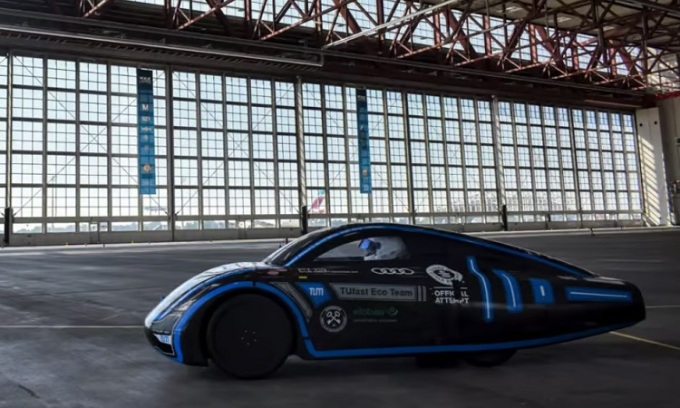A group of students from the Technical University of Munich (TUM) built an ultra-light electric car that set a world record for range.

TUfast Eco equipped a larger battery pack for the Muc022 electric vehicle to complete the record. Photo: TUfast Eco
With a single charge of more than 2,500 km, TUM students broke the record for the longest range electric vehicle (not a solar electric vehicle). The new record is several times higher than the parameters of the production car of the luxury electric car company Lucid Air (over 805 km). The single-seat Muc022 vehicle has an aerodynamic shape and operates with a 15.5 kWh battery, New Atlas reported on September 13.
The students in the TUfast Eco team at TUM don’t drive more than 2,500 km in a day, especially when they need to enter the Guinness Book of World Records by beating the current range record of 1,608.54 km on a single charge. Instead, they spent seven days at the Munich Mobility car show last week trying to set the record. They drove in a hangar provided by Munich Airport to eliminate the effects of the weather for almost a week.
The TUfast Eco team not only became the first to run more than 1,000 miles. They beat the previous record set by the US company IT Asset Partners in California in 2017 by 60%. The students set the record in four days and spent the remaining two days pushing the number as high as they could before their batteries ran out.
The TUM students completed a distance of 1,600 km with only a 15.5 kWh battery pack, which can be compared to the leading hybrid or electric cars on the market today such as Lucid Air Grand Touring and Tesla Model S. The above figure is equivalent to 0.6 kWh/100 km, much lower than the common efficient energy consumption for electric cars of 13 kWh/100 km.
Developed last year, the vehicle is designed specifically for competition. The Muc022’s elongated, teardrop-shaped body has a drag coefficient of 0.159, lower than any other vehicle on the market, including the Lightyear 0 solar electric car. The Muc022 weighs just 170 kg without the driver, minimizing the need for a 400 W permanent magnet synchronous motor.
An Khang (According to New Atlas )
Source link
























































![[Maritime News] Container shipping faces overcapacity that will last until 2028](https://vphoto.vietnam.vn/thumb/402x226/vietnam/resource/IMAGE/2025/7/30/6d35cbc6b0f643fd97f8aa2e9bc87aea)













































Comment (0)